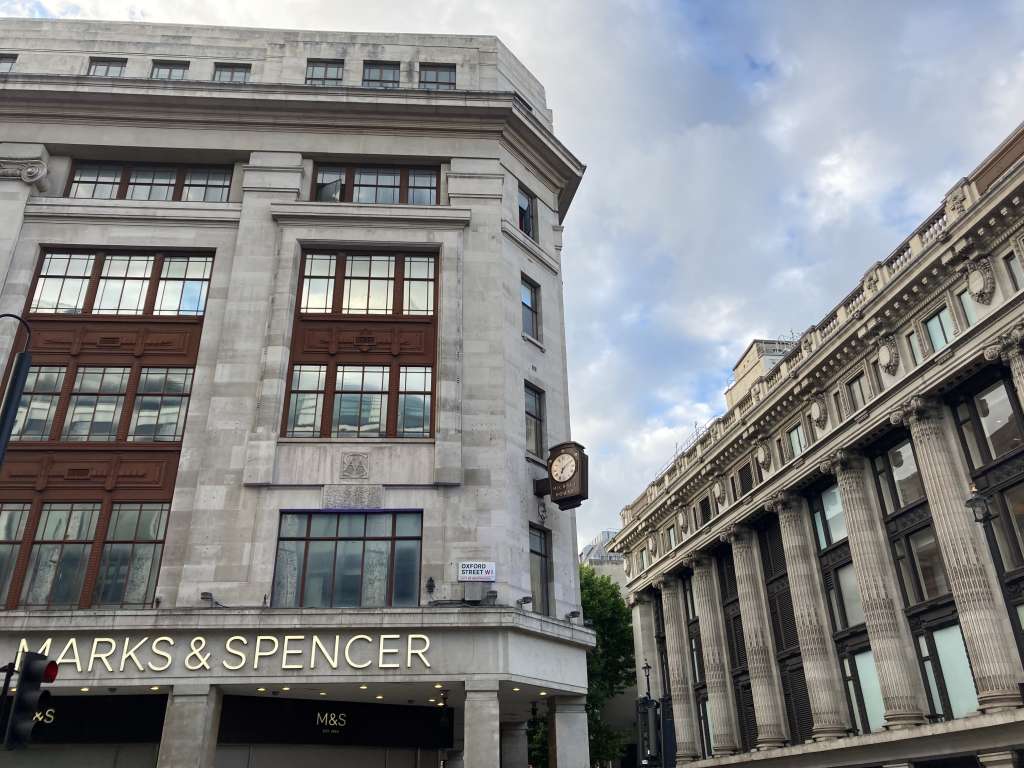PRESS RELEASE: Experts write to Planning Inspector backing SAVE’s case for M&S Oxford Street
4th August 2022
Top architects and author submit statements to public inquiry
Leading architects and sustainability specialists are lining up to support SAVE’s battle to stop M&S bulldozing its flagship store on Oxford Street.
A series of experts have submitted statements in support of SAVE’s case to the Planning Inspector ahead of the public inquiry which opens in October. SAVE Britain’s Heritage will be going head-to-head with M&S at the inquiry and has launched a crowdfunding appeal towards our legal costs.
In addition to the expert witnesses who will give evidence at the public inquiry, SAVE has been enormously heartened by the number of architects, engineers and other specialists who have pledged their support by submitting statements to the Planning Inspector arguing the handsome 1929 building near Marble Arch should be retained.
Dr Alice Moncaster is an engineer and academic at the Open University and the University of Cambridge who has spent 15 years researching the embodied and whole-life emissions of buildings and construction projects. She is the editor of two textbooks on the subject and author of more than 100 peer-reviewed articles. She has also advised the UK Parliament and International Energy Agency.
In a detailed technical statement submitted to the inspector she said: “The embodied carbon of new buildings is far higher than that of deep retrofit.
“The proposed demolition [of the M&S building] and new construction will emit many thousands of tonnes of greenhouse gas emissions, increasing our impact on climate change. Retrofitting the existing building up to equivalent energy standards would emit considerably less carbon. I therefore urge you to refuse this application.”
She says our understanding of energy use in buildings has been transformed in recent years. We now know that embodied carbon (the energy used to create materials like steel and concrete for new buildings) is far more significant than previously thought.
Dr Moncaster added: “It is commercially viable to retrofit such a building, as demonstrated by the fact that similar projects are happening elsewhere in the UK. One such is the Rylands building in Manchester, a 1930s building most recently occupied by Debenhams which is being refurbished and extended.
“The M&S building should not be demolished and replaced, but should be refurbished.”
Mark Hines, an architect specialising in the reuse of historic buildings, said: “We all need to get used to the idea that creating new architecture uses vast amounts of energy.
“As we face up to the challenges of achieving net zero targets, M&S have a tremendous opportunity to lead the way and let their corporate values shine through in their architecture. A thoughtful refurbishment of their own landmark Oxford Street store would show their customers the true value of our existing buildings in the 21st century and how they can be transformed.”
Mr Hines is principal of Mark Hines Architects and was the project architect responsible for the transformation of the BBC’s Broadcasting House in central London. This project secured the grade II*-listed landmark’s future by remodelling it for contemporary broadcasting requirements while halving carbon emissions and cutting estate costs by £736m.
Architect Ian Ritchie CBE, a Royal Academician and honorary visiting professor of architecture at Liverpool University, has also submitted a statement to the Planning Inspector. Recent projects by his practice Ritchie Studio include the repurposing of two landmark retail premises in Covent Garden, successful examples of the reuse of historic buildings.
He said: “At the beginning of this millennium, it became clear that retention of the fabric of buildings was becoming an imperative to reduce energy consumption, reduce material waste and reduce atmospheric carbon. It also serves to keep urban memories, through façades, but also to exploit the structure and internal volumes. Retrofit, re-use and re-purposing buildings remain a vitally important challenge for architecture.”
Mr Ritchie, whose practice was also responsible for the reimagining of Madrid’s Reina Sofia Museum of Modern Art in the 1980s and the reuse of viaduct arches as part of London Underground’s Jubilee Line Extension in the 1990s, said: “I am convinced this approach is totally feasible with the M&S building.”
ENDS
Notes to editors:
1/ For more information contact Elizabeth Hopkirk: elizabeth.hopkirk@savebritainsheritage.org / 020 7253 3500.
2/ To submit a statement to the public inquiry in support of retaining and retrofitting the M&S building at 458 Oxford Street, write to the Secretary of State c/o the Planning Inspectorate case officer alison.dyson@planninginspectorate.gov.uk citing PINS ref: APP/X5990/V/22/3301508.
Copy in Cllr Geoff Barraclough, Westminster council’s cabinet member for planning & economic development, gbarraclough@westminster.gov.uk, the new Secretary of State, greg.clark@levellingup.gov.uk, and us: office@savebritainsheritage.org.
3/ Support our fundraising appeal here.
4/ Find links to our previous press releases on the M&S building here.
5/ SAVE Britain’s Heritage is an independent voice in conservation that fights for threatened historic buildings and sustainable reuses. We stand apart from other organisations by bringing together architects, engineers, planners and investors to offer viable alternative proposals. Where necessary, and with expert advice, we take legal action to prevent major and needless losses.




